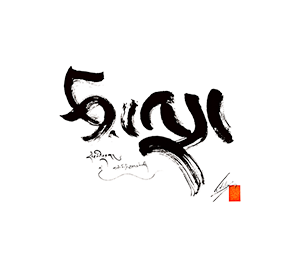'jam dbyangs mkhyen brtse'i dbang po: Difference between revisions
No edit summary |
No edit summary |
||
| Line 6: | Line 6: | ||
<div class="text-130 font-serif line14"> | <div class="text-130 font-serif line14"> | ||
Jamyang Khyentse Wangpo, the famed 19th century Tibetan polymath, was arguably the most prolific member of the Khyentse Lineage. Not only in terms of his own writings, which are presented here in collections that amount to forty-seven Tibetan volumes, but also in terms of the influence he exerted on the religious culture of Tibet and the Himalayan region. In fact, it is difficult to imagine what Tibetan Buddhism might look like today without him. In an era that witnessed a remarkable period of renewal and creativity, replete with the emergence of towering figures, Khyentse Wangpo can still be described as incomparable. Under his auspices, Jamgön Kongtrul and Loter Wangpo produced literary collections that virtually ensured the survival of a thousand years of Buddhist scriptural output. Yet without the transmissions of the works contained within the hundreds of collective volumes of the ''Rinchen Terdzö'', the ''Kagyu Ngak Dzö'', '' | Jamyang Khyentse Wangpo, the famed 19th century Tibetan polymath, was arguably the most prolific member of the Khyentse Lineage. Not only in terms of his own writings, which are presented here in collections that amount to forty-seven Tibetan volumes, but also in terms of the influence he exerted on the religious culture of Tibet and the Himalayan region. In fact, it is difficult to imagine what Tibetan Buddhism might look like today without him. In an era that witnessed a remarkable period of renewal and creativity, replete with the emergence of towering figures, Khyentse Wangpo can still be described as incomparable. Under his auspices, Jamgön Kongtrul and Loter Wangpo produced literary collections that virtually ensured the survival of a thousand years of Buddhist scriptural output. Yet without the transmissions of the works contained within the hundreds of collective volumes of the ''Rinchen Terdzö'', the ''Damngak Dzö'', the ''Kagyu Ngak Dzö'', ''Gyude Kuntu'' and the ''Drupthab Kuntu'', which were painstakingly gathered and embodied by Khyentse Wangpo, those collections would have been little more than dry ink on paper, rather than the life force of a living tradition. His seal of approval brought recognition to figures that would come to shape the tradition we see today. The names Mipham Gyamtso and Chogyur Lingpa might have meant little to us had Khyentse Wangpo not recognized and nurtured their potential, thus catapulting them into the spotlight and imbuing their activities with an unassailable authority and stature. | ||
The literary corpus of Jamyang Khyentse Wangpo is divided into two collections, which can be loosely categorized in relation to his authoritative transmissions and his compositions. | The literary corpus of Jamyang Khyentse Wangpo is divided into two collections, which can be loosely categorized in relation to his authoritative transmissions and his compositions. | ||
Revision as of 10:46, 12 August 2021
Collections
2632 texts associated with this figure
Terton Gyatsa Information
| Name in Gyatsa (Tibetan) | པདྨ་འོད་གསལ་མདོ་སྔགས་གླིང་པ་ |
|---|---|
| Name in Gyatsa (Wylie) | pad+ma 'od gsal mdo sngags gling pa |
| Page numbers | Rinchen Terdzö, Volume I, Text #6, Pages 676 to 693, folio 168b2 to 177a3 |
| Biography |
|
The Writings of Jamyang Khyentse Wangpo
Jamyang Khyentse Wangpo, the famed 19th century Tibetan polymath, was arguably the most prolific member of the Khyentse Lineage. Not only in terms of his own writings, which are presented here in collections that amount to forty-seven Tibetan volumes, but also in terms of the influence he exerted on the religious culture of Tibet and the Himalayan region. In fact, it is difficult to imagine what Tibetan Buddhism might look like today without him. In an era that witnessed a remarkable period of renewal and creativity, replete with the emergence of towering figures, Khyentse Wangpo can still be described as incomparable. Under his auspices, Jamgön Kongtrul and Loter Wangpo produced literary collections that virtually ensured the survival of a thousand years of Buddhist scriptural output. Yet without the transmissions of the works contained within the hundreds of collective volumes of the Rinchen Terdzö, the Damngak Dzö, the Kagyu Ngak Dzö, Gyude Kuntu and the Drupthab Kuntu, which were painstakingly gathered and embodied by Khyentse Wangpo, those collections would have been little more than dry ink on paper, rather than the life force of a living tradition. His seal of approval brought recognition to figures that would come to shape the tradition we see today. The names Mipham Gyamtso and Chogyur Lingpa might have meant little to us had Khyentse Wangpo not recognized and nurtured their potential, thus catapulting them into the spotlight and imbuing their activities with an unassailable authority and stature.
The literary corpus of Jamyang Khyentse Wangpo is divided into two collections, which can be loosely categorized in relation to his authoritative transmissions and his compositions.
Collections
2632 texts associated with this figure
